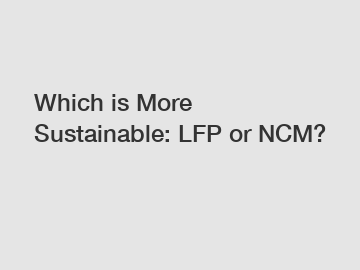Feb. 28, 2024
Electrical Equipment
Which is More Sustainable: LFP or NCM?
Lithium-ion batteries have revolutionized various industries, from consumer electronics to electric vehicles. However, the debate over which cathode material is more sustainable – lithium iron phosphate (LFP) or nickel-cobalt-manganese (NCM) – has been ongoing. In the search for environmentally friendly energy storage solutions, it is essential to determine which option is the most sustainable.
The sustainability of a battery depends on various factors, including resource availability, environmental impact, and energy density. LFP, known for its safety and long lifespan, is more abundant and less expensive than NCM. Its simple composition also makes it easier to recycle, reducing the environmental impact of the battery manufacturing process. On the other hand, NCM batteries offer higher energy density and better overall performance, making them popular choices for electric vehicles.

To determine which cathode material is more sustainable, a life cycle assessment (LCA) can be conducted. This analysis considers all stages of a battery's life, from material extraction to end-of-life disposal. Studies have shown that LFP batteries have a lower environmental impact compared to NCM batteries due to their simpler composition and easier recyclability. In terms of energy storage capacity, NCM batteries outperform LFP batteries, but the trade-off lies in their higher environmental footprint.
The choice between LFP and NCM batteries ultimately depends on the specific application and sustainability goals. For applications where safety and long lifespan are critical, such as stationary energy storage systems, LFP batteries may be the more sustainable option. In contrast, for applications that require high energy density and performance, such as electric vehicles, NCM batteries may be preferred despite their higher environmental impact.
In conclusion, the sustainability of LFP and NCM batteries depends on a balance between performance and environmental impact. While NCM batteries offer higher energy density and performance, they come at the cost of a higher environmental footprint. On the other hand, LFP batteries are more environmentally friendly due to their simpler composition and easier recyclability. As the demand for energy storage solutions continues to grow, it is essential to consider the sustainability of different battery technologies to make informed decisions that support a greener future.
Want more information on lithium iron phosphate battery vs lithium ion, forklift battery voltage, LFP Contact? Feel free to contact us.
Previous: Are wire connectors up to code?
Next: Top Porcelana Ads Clamp Fabricante: Answering Your Google FAQs
If you are interested in sending in a Guest Blogger Submission,welcome to write for us!
All Comments ( 0 )